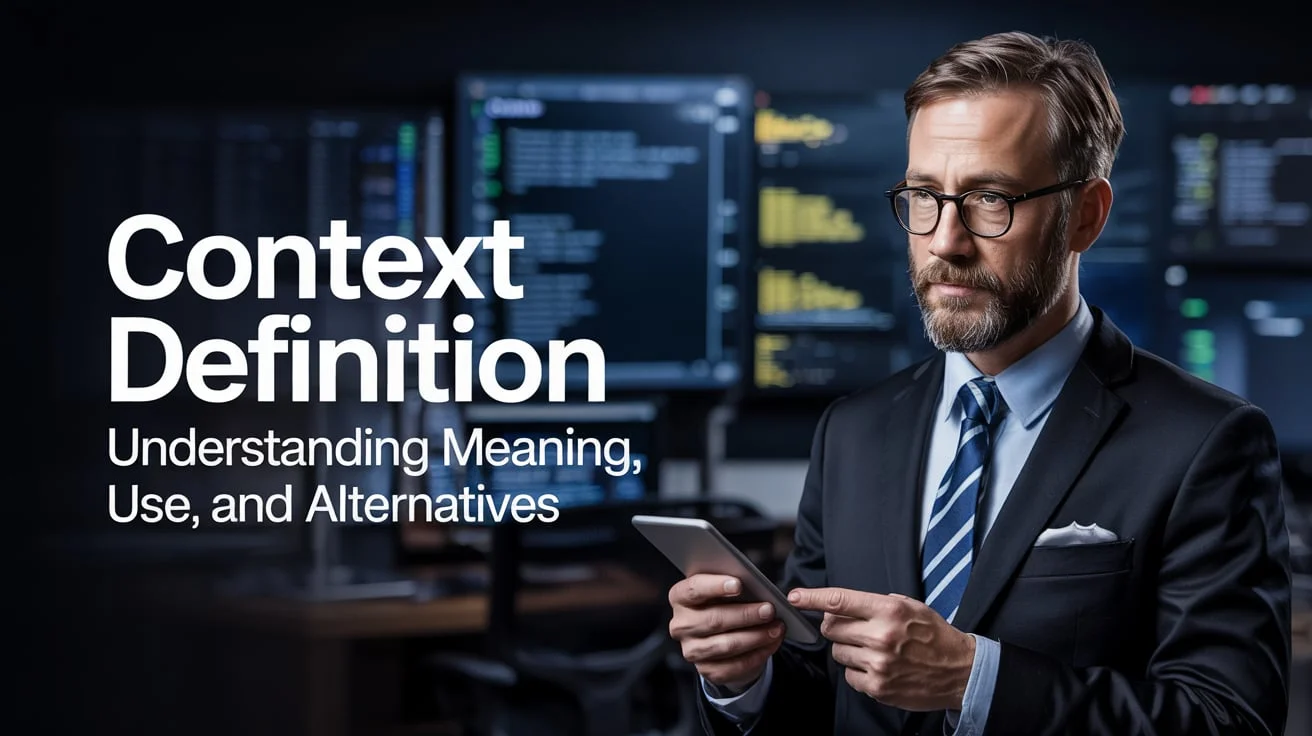Understanding context isn’t a trivial exercise in semantics. It’s the invisible thread weaving meaning, guidance, and nuance into every conversation, text, system, and decision. In this post, you’ll get a clear, detailed exploration of what context is, how it works, where it’s essential, and what concepts sometimes serve instead. Let’s dive in.
Text messages, tweets, code, laws — all of them rely on context. A sentence pulled from its surroundings often changes meaning. Misreading tone in a chat leads to conflict. Misconfiguring context in software causes bugs.
That’s the problem: people toss around “context” without grasping its depth. This article unpacks context’s meaning, shows how it operates in real life and in tech, and then explores alternatives you can use when context fails or isn’t enough.
By the end, you’ll:
- Grasp crisp definitions of context across disciplines
- See how different types of context influence interpretation
- Recognize pitfalls when context is missing or misused
- Learn strategies to analyze and apply context
- Know related notions (framing, subtext, metadata) and when they help
What Is Context?
Etymology & Historical Roots
The word context comes from the Latin contexere, meaning “to weave together.” The idea is that meaning emerges only when you stitch pieces — words, events, conditions — into a fabric.
Over centuries, philosophers, linguists, and logicians debated whether meaning is inherent or depends on surroundings. Today, most agree that context plays a central role in how we interpret signs.
Core Definitions
- General usage: The circumstances, conditions, or environment in which something exists or occurs.
- Linguistic / discursive sense: The words, phrases, speech acts surrounding a unit of discourse that help clarify meaning.
- Broader communicative / semiotic sense: All external and internal factors (cultural, social, psychological) that influence how a message is produced or interpreted.
One way to see the difference: cotext refers strictly to neighboring text, whereas context includes external knowledge, environment, and situation.
Why Context Matters
- Disambiguation. Words often carry multiple meanings (polysemy). Context helps choose the correct one.
- Framing. It sets the lens through which a message is seen (tone, emphasis).
- Relevance filtering. Context helps us ignore irrelevant information and focus on what matters.
- Expectation management. It shapes what receivers think is likely or permissible in a given situation.
Without context, communication often becomes vague, misleading, or even nonsensical.
Types or Dimensions of Context
Expecting one single “context” won’t work. Different layers of context overlap and interplay. Here are major types you need to know.
Situational / Physical Context
This refers to the “where, when, and with whom” setting:
- Time, location, surroundings
- Physical objects present
- Who is involved (people, roles)
- Environmental constraints (noise, lighting, formality)
Example: In a dark alley at midnight, “Be careful” has a different weight than in a bright office at noon.
Linguistic / Textual Context
This is the co-text: the sentences before and after, the discourse structure, the genre. It helps interpret:
- pronouns (“he,” “it”)
- elliptical or truncated speech
- ambiguous modifiers
E.g. “She left early.” — who is “she”? What “left”? You need prior text.
Cultural / Social Context
Includes background knowledge, norms, shared beliefs, values, idioms, traditions.
Example: A phrase like “break a leg” in theater means “good luck.” Outside that cultural frame, it looks violent.
Psychological / Cognitive Context
The mental state of speaker(s) and audience:
- Beliefs, expectations, prior knowledge
- Emotions, moods, intents
- Perspectives, biases
This context is tricky because it’s internal, but it drives interpretation strongly.
Technical / Domain Context
In specialized fields, domain-specific rules, jargon, protocols, and system states form context:
- Programming: runtime environment, dependencies
- Medicine: patient history, lab norms
- Business: financial benchmarks, market trends
If you talk “cache,” domain context tells if you mean web cache or storage.
How Context Operates in Practice
Let’s see how context shows up in communication, writing, tech, and decision-making.
In Communication & Conversation
- Pronoun resolution: “She told him to go.” Who is “she”? Context sorts that.
- Ellipsis and implied meaning: “Want dessert?” — implied you and me.
- Repairing ambiguity: If someone says “I saw her duck,” you need context to know if “duck” is the bird or the action.
In Writing & Reading
Writers embed cues; readers play detective. For example:
“He ran. The door slammed shut.”
Without context, we don’t know who “he” is or what “the door” means. But earlier lines often supply that.
Example of ambiguity resolved by context:
- “She gave me a ring.”
- In a jewelry catalog — “ring” means piece of jewelry
- In a phone ad — “ring” means phone call
Writers often use foreshadowing, consistent vocabulary, and relation patterns to scaffold meaning.
In Technology & Software
- Context-aware apps: Apps detect your location, time, or device state to adapt behavior (e.g. switch to dark mode, mute notifications).
- Context in AI / NLP: Models like GPT use preceding text and metadata to interpret prompts.
- Operational context in autonomous systems: A driverless car must understand road type, weather, speed limits, traffic. A case study found industry struggles to define operational context clearly.
In Decision-Making
Leaders rarely act on raw data alone. They interpret it against contextual layers:
- Market trends, economy, culture
- Stakeholder expectations
- Organizational history
A financial figure looks good in isolation but may be terrible given the industry’s temperature or peer benchmarks.
Common Pitfalls & Challenges
Even experts slip up when context falters. Recognizing these traps helps you avoid them.
- Overreliance leading to bias. If you assume too much context, you might confirm your preconceptions instead of questioning them.
- Context collapse. Online, multiple audiences share the same space. Your words meant for one group might misfire to another.
- Missing or incomplete context. Without enough clues, interpretation breaks.
- Conflicting context. Cultural norms may clash with technical constraints or business objectives.
- Opaque contexts in language. Some contexts prevent substituting synonyms without changing truth (e.g. “Lois believes Superman is a hero” vs “Lois believes Clark Kent is a hero”) — known as opaque context.
How to Analyze & Apply Context Effectively
You need more than insight — you need tools and strategies. Here’s how to work with context.
Asking the Right Questions
Before interpreting anything, pause and ask:
- Who is communicating?
- When and where does this happen?
- What previous statements or events led here?
- What assumptions might both parties hold?
- What are possible interpretations, and which are most plausible given the rest?
Context Mapping or Modeling
Create visual or structured representations of relevant context. Techniques include:
- Mind maps: Place the focal message in center; branch out situational, social, linguistic, and cognitive contexts.
- Tables or matrices: Compare context types side by side.
- Storyboards: Sequence events showing how context evolves over time.
Here’s a simple table example:
| Context Type | Key Elements | Why It Matters |
| Situational | Time, location, participants | Anchors what’s real vs hypothetical |
| Linguistic | Co-text, preceding statements | Helps resolve ambiguity (pronouns, etc.) |
| Cultural / Social | Norms, idioms, shared beliefs | Shapes implied meaning and subtext |
| Cognitive / Psychological | Beliefs, emotions, expectations | Drivers of how message is interpreted |
| Technical / Domain | Jargon, protocols, system states | Defines what terms or constraints apply |
Layering & Prioritizing Contexts
Not all context matters equally in every situation. Focus first on the dominant layers. For example:
- In a business memo, technical domain context and organizational history may override linguistic subtext.
- In poetry, cultural and linguistic context may dominate.
You can filter out “noise” (irrelevant context) to concentrate your interpretation.
Read More: Pedrovazpaulo Executive Coaching: The Key to Transformational Leadership
Testing Contextual Assumptions
When in doubt, test your assumptions:
- What-if scenarios: “If I change the time or place, does meaning shift?”
- Counterfactuals: “What if I remove the assumed background knowledge?”
- Ask others: Get external perspectives to confirm or challenge your interpretation.
- Iterate context: As you gather more information, refine your context model.
Alternatives & Related Concepts
Sometimes contextual knowledge isn’t enough or isn’t directly accessible. Here are concepts that can supplement or substitute it.
Subtext & Implicit Meaning
Subtext is what’s unsaid. It lives between the lines. Writers and speakers rely on shared context to embed it. When context is weak, subtext can misfire.
Framing & Reframing
How you present the same facts changes perception. Framing is context in narrative form.
- Example: “70% fat-free” vs “30% fat” — same product, different frame.
- Reframing a problem can transform how the audience sees it.
Metadata & Annotations
Sometimes you can’t rely on human inference. You annotate the context explicitly.
- In code: comments, documentation
- In data: tags, descriptive fields
- In documents: footnotes, background sections
Metadata is a structured context.
Context-Free / Abstract Representations
In math, formal logic, or certain computational models, you remove context to isolate pure structure. That works when you only care about universal, context-independent relationships. But pure context-free models often fail when you reintroduce real-world complexity.
E.g., context-free grammars in computer science describe sentence structures without regard to meaning or external world fact.
In summary, these alternatives can help when context is invisible, ambiguous, or too messy—but each has limits.
Real-World Case Studies
Let’s ground theory in practice. Here are a few illuminating cases.
Case Study: Autonomous Driving & Operational Context
In one industry study, defining an autonomous vehicle’s Operational Design Domain (ODD) — essentially its contextual operating boundaries — proved challenging. Developers struggled with:
- Ambiguities in assumptions (e.g. weather, road quality)
- Lack of standardization across functions
- Insufficient documentation of context assumptions
Because context definitions were fuzzy, safety guarantees became weaker.
This reveals how crucial technical context is when building real-world systems.
Case Study: Physics Faculty Development
In a longitudinal study of two physics instructors, their professional growth hinged on how well they navigated local context:
- Institutional culture
- Peer expectations
- Student demographics
Even though both were experts, their trajectories diverged because they treated context differently.
The researchers showed that context isn’t static; it evolves, and success comes when you adjust.
Case Study: Tech Adoption & Healthcare Context
Researchers investigated mHealth (mobile health) tech usage in Kenya. They framed healthcare-seeking itself as a minimum context to explain technology adoption. They discovered:
- Users’ past healthcare behaviors shaped how they accepted new tech
- Trust in the system often depended on trust in existing medical institutions
- Contextual friction (e.g. connectivity, cultural norms) affected continuation
This showed how a human-domain context must integrate with technical design.
Best Practices & Tips (Actionable Guidance)
Here are techniques you can use right away.
- Always probe for hidden contexts. Assume there are more layers than you see.
- Document context assumptions explicitly, especially in teams or projects.
- Use multiple context types — don’t rely on only one.
- Revisit context regularly — contexts shift over time.
- Use clear signals (labels, glosses, definitions) to reduce ambiguity.
- Test with outsiders — ask someone unfamiliar to interpret your message.
- Be cautious of overcontextualizing — too much assumed context can alienate newcomers.
Conclusion
Context is far more than a side note; it’s the backbone of meaning. Whether you’re reading a novel, decoding a message, designing software, or making decisions, context is your guide. You learned:
- What context is across domains
- How various context types affect interpretation
- Real-world examples of context success and failure
- Techniques to analyze, map, and test context
- Alternatives like framing, subtext, and metadata
Mastering context is not a one-time skill. It’s an ongoing practice. Start with your next conversation, message, or design: pause, ask context-questions, sketch a map, test your assumptions. Over time you’ll see deeper meanings, avoid misfires, and communicate with far greater precision.
If you like, I can produce a downloadable visual context-mapping template, or turn this into a shareable infographic. Do you want me to do that?

The creative soul behind the scenes at PunnyPeeks, Emma Brooke is a curator of charm, color, and celebration. With a love for design and a knack for playful storytelling, Emma brings every event to life with custom balloon decor that speaks louder than words. Her mission? To turn simple moments into joyful memories—full of flair, laughter, and a touch of pun-loving magic.




